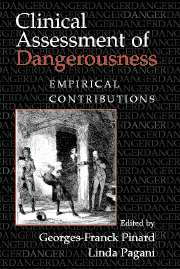Book contents
- Frontmatter
- Contents
- Contributors
- Prologue
- Introduction
- Basic Issues in Violence Research
- Mental Health Issues and Dangerousness
- Family Issues and Dangerousness
- Individual Characteristics and Dangerousness
- 11 Alcohol and Dangerousness
- 12 Violence and Substance Abuse
- 13 Threats, Stalking, and Criminal Harassment
- Conclusion
- Index
11 - Alcohol and Dangerousness
Published online by Cambridge University Press: 03 July 2009
- Frontmatter
- Contents
- Contributors
- Prologue
- Introduction
- Basic Issues in Violence Research
- Mental Health Issues and Dangerousness
- Family Issues and Dangerousness
- Individual Characteristics and Dangerousness
- 11 Alcohol and Dangerousness
- 12 Violence and Substance Abuse
- 13 Threats, Stalking, and Criminal Harassment
- Conclusion
- Index
Summary
The co-occurrence of misbehavior and drinking have typically colored perceptions of the role alcohol plays in criminal behavior. For example, a recent U.S. Government publication provides figures of coincidences between alcohol use and dangerous conduct as indicating “extensive and far-reaching impacts of alcohol abuse on crime and public safety” (Greenfeld, 1998, p. 1). The author notes that he and co-investigators found “that nearly 4 in 10 violent victimizations involve use of alcohol, about 4 in 10 fatal motor vehicle accidents are alcohol-involved; and about 4 in 10 offenders, regardless of whether they are on probation, in local jail, or in state prison, self-report that they were using alcohol at the time of the offense.”
Although drinking, fighting, and street crimes frequently occur at the same times and places, that is insufficient grounds for concluding that drinking causes fighting or street crimes. Furthermore, although many people who do dangerous things also drink, the nature of that relationship is far from certain.
This chapter examines several types of connections between alcohol consumption and criminality. The first section considers links between criminal behavior and drinking from historical perspectives. The section shows how development of a social agenda helped shape research strategies. The second section describes alcohol-related crimes, indicating their changing patterns. The third section focuses on syndromes, rather than incidents or events. The section focuses on the overlap of symptoms attributed to antisocial behavior disorder and alcoholism, and on their etiology and development.
- Type
- Chapter
- Information
- Clinical Assessment of DangerousnessEmpirical Contributions, pp. 195 - 215Publisher: Cambridge University PressPrint publication year: 2000
- 1
- Cited by



